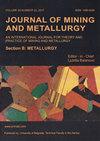Effect of water vapor on the reduction kinetics of hematite powder by hydrogen-water vapor in different stages
IF 1
4区 材料科学
Q3 METALLURGY & METALLURGICAL ENGINEERING
Journal of Mining and Metallurgy Section B-Metallurgy
Pub Date : 2023-01-01
DOI:10.2298/jmmb220523006m
引用次数: 0
Abstract
The powder of hematite sample was isothermally reduced with hydrogen-water vapor gas mixture at 1023K-1273K. The results indicated that the overall reduction process of hematite could be separated into three stages (Fe2O3-Fe3O4-FeO-Fe) to respectively study. At 1023K, the average reaction rate dropped by 53.6% in the stage 1 when the water vapor content of gas reactant rose from 0% to 50%, and it decreased by about 77.2% in the stage 2. However, in the stage 3, when the water vapor content only increased from 0% to 20%, it decreased by about 78.1%. Besides, the average reaction rate had a roughly negative linear relationship with the water vapor content, and the results further shown that the effect of water vapor on the reduction reaction increased with increasing reaction temperature at all stages of the reduction reaction. The microstructure of reduction products showed that it still had some holes, which the channel for hydrogen diffusion was not seriously blocked. In order to further clarify the influence of water vapor in the reduction stage, different models were considered, and the range of apparent activation energy of different stages obtained by model fitting was about 20-70 kJ/mol, which also confirmed the absence of solid-state diffusion phenomenon.水蒸气对不同阶段赤铁矿粉氢-水蒸气还原动力学的影响
在1023K-1273K温度下,用氢-水蒸气混合气体等温还原赤铁矿粉料。结果表明,赤铁矿整体还原过程可分为Fe2O3-Fe3O4-FeO-Fe三个阶段分别进行研究。在1023K时,当气态反应物的水蒸气含量从0%上升到50%时,阶段1的平均反应速率下降了53.6%,阶段2的平均反应速率下降了约77.2%。而在第3阶段,当水蒸气含量仅从0%增加到20%时,下降了约78.1%。平均反应速率与水蒸气含量大致呈负线性关系,结果进一步表明,在还原反应的各个阶段,水蒸气对还原反应的影响随反应温度的升高而增大。还原产物的微观结构表明,还原产物中仍有一些孔洞,氢扩散通道未被严重阻断。为了进一步明确水蒸气在还原阶段的影响,考虑了不同的模型,通过模型拟合得到的不同阶段的表观活化能范围约为20-70 kJ/mol,也证实了不存在固态扩散现象。
本文章由计算机程序翻译,如有差异,请以英文原文为准。
求助全文
约1分钟内获得全文
求助全文
来源期刊
CiteScore
2.00
自引率
40.00%
发文量
19
审稿时长
2 months
期刊介绍:
University of Belgrade, Technical Faculty in Bor, has been publishing the journal called Journal of Mining and Metallurgy since 1965 and in 1997 it was divided in two independent journals dealing with mining and metallurgy separately. Since 2009 Journal of Mining and Metallurgy, Section B: Metallurgy has been accepted in Science Citation Index Expanded.
Journal of Mining and Metallurgy, Section B: Metallurgy presents an international medium for the publication of contributions on original research which reflect the new progresses in theory and practice of metallurgy. The Journal covers the latest research in all aspects of metallurgy including hydrometallurgy, pyrometallurgy, electrometallurgy, transport phenomena, process control, solidification, mechanical working, solid state reactions, materials processing, surface treatment and relationships among processing, structure, and properties of materials.

 求助内容:
求助内容: 应助结果提醒方式:
应助结果提醒方式:


